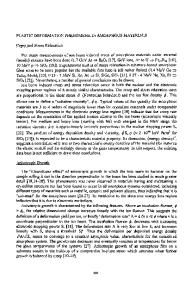Plastic Deformation of Bulk Amorphous Alloys
- PDF / 942,141 Bytes
- 6 Pages / 612 x 792 pts (letter) Page_size
- 42 Downloads / 446 Views
Plastic Deformation of Bulk Amorphous Alloys L.Q. Xing and T.C. Hufnagel Department of Materials Science and Engineering, Johns Hopkins University, Baltimore, MD 21218, USA K.T. Ramesh Department of Mechanical Engineering, Johns Hopkins University, Baltimore, MD 21218, USA
Abstract We have studied plastic deformation, including “serrated flow,” of bulk metallic glasses under quasi-static uniaxial compression. The deformation response is essentially elastic-perfectly plastic, but the “plastic” deformation actually consists of sections of elastic loading separated by abrupt load drops. The load drops are due to the formation of shear bands, which represent the primary mechanism of plastic deformation In Zr-Ti-Cu-Ni-Al bulk metallic glasses, fracture occurs after about 1-2% plastic strain, but in Zr-Ta-Cu-Ni-Al metallic glass the plastic strain to failure can be as large as 6-7%. The difference appears to be due a strong tendency for the shear bands in this alloy to branch. The branching presumably reduces the stress concentration on the shear bands, retarding the onset of fracture. No evidence is seen for the formation of crystalline phases in this alloy.
1. Introduction Bulk metallic glasses exhibit high yield stresses and large elastic deformations but typically display limited plastic flow (0.5-1.5% under uniaxial compression) at room temperature [1-2]. Plastic deformation of a fully amorphous alloy occurs without work hardening. Unlike crystalline metals, the plastic deformation in metallic glasses is highly localized into very narrow regions called shear bands. To a large extent, efforts to increase the ductility of metallic glasses focus on controlling the initiation and propagation of these shear bands. In an effort to increase the plastic flow, particularly under tensile loading, composite structures consisting of crystalline particles embedded in amorphous matrix have been developed [3-4]. Ductile crystalline particles of micrometer size in an amorphous matrix increase the plastic strain to failure; such materials exhibit work hardening similar to that of crystalline alloys [5]. The crystallites promote the initiation of shear bands and also inhibit their propagation. Brittle precipitates of micrometer size, on the other hand, reduce plastic flow and yield strength [6]. Moreover, partially crystallized metallic glasses containing nanometer-scale crystalline precipitates exhibit increased yield strength without significantly reduced ductility [2,7].
L11.7.1
The focus of the present work is on developing an understanding of the nature of plastic flow in bulk amorphous alloys, and on ways to increase ductility by controlling shear bands. We show that shear band propagation can be influenced by adjusting the alloy composition, and that these changes can give significantly enhanced ductility, at least under uniaxial compression.
2. Experimental procedures We prepared samples of Zr57Ti5Cu20Ni8Al10 and Zr59Ta5Cu18Ni8Al10 metallic glass by arc melting in a copper hearth, followed by suction casting into a coppe
Data Loading...











